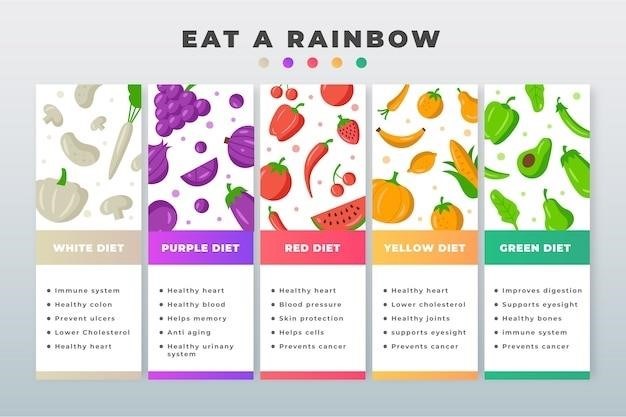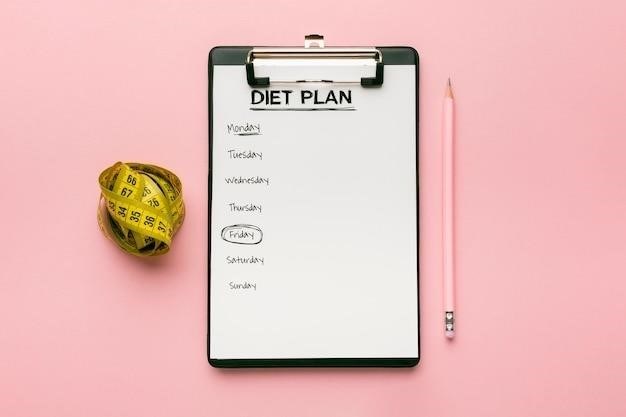Understanding the Ulcer Diet
There’s no single ulcer diet‚ but certain foods may ease symptoms. Current research focuses on Helicobacter pylori infection’s role in ulcer formation. Treatment usually involves medication‚ including antibiotics. Dietary adjustments can complement this treatment‚ promoting healing and comfort.
Foods to Include for Ulcer Healing
Prioritizing foods rich in nutrients is crucial for ulcer healing. A balanced diet aids the healing process. Gentle on the stomach‚ include options like yogurt‚ a probiotic source‚ supporting gut health. Whole grains and fiber-rich fruits offer benefits; fiber can lower stomach acid and ease discomfort. Lean proteins such as chicken‚ turkey‚ fish‚ and tofu are easier to digest and less likely to trigger acid production. Bananas‚ melons‚ and apples are non-acidic‚ providing essential vitamins without irritation. Berries‚ eggs‚ and lean meats may also help manage symptoms. Avoid fried foods‚ citrus fruits‚ and alcohol‚ which can irritate ulcers. Fatty fish like salmon offer omega-3s‚ reducing inflammation. Skinless poultry‚ lean beef‚ and beans provide low-fat protein. A balanced diet encompassing these elements supports faster healing and symptom relief. Remember to consult with a healthcare professional for personalized dietary advice.
Beneficial Nutrients and Their Sources
Certain nutrients play a vital role in ulcer healing and overall digestive health. Vitamin A‚ linked to a reduced ulcer risk‚ is abundant in sweet potatoes‚ carrots‚ spinach‚ and kale. Zinc‚ essential for tissue repair‚ is found in pumpkin seeds‚ chickpeas‚ and lentils. Probiotics‚ beneficial bacteria supporting gut health‚ are present in yogurt and kefir. Omega-3 fatty acids‚ possessing anti-inflammatory properties‚ are rich in fatty fish like salmon and mackerel. Fiber‚ crucial for digestive regularity and acid reduction‚ is plentiful in whole grains‚ fruits‚ and vegetables. Adequate protein intake‚ vital for tissue repair‚ can be obtained from lean sources like chicken‚ fish‚ and beans. Vitamin C‚ an antioxidant supporting healing‚ is found in citrus fruits (consume moderately)‚ berries‚ and bell peppers. Including these nutrient-rich foods in your diet can significantly improve ulcer healing and prevent future occurrences. Always consult with your doctor or a registered dietitian for personalized dietary guidance.
Lean Protein Options for a Healthy Diet
Lean protein is crucial for tissue repair and overall health during ulcer healing. Prioritize options gentle on the stomach and less likely to trigger acid production. Excellent choices include skinless poultry like chicken and turkey‚ which offer high-quality protein with minimal fat. Fish‚ particularly fatty varieties such as salmon and mackerel‚ provide omega-3 fatty acids‚ reducing inflammation and supporting healing. Lean cuts of beef‚ like sirloin or tenderloin‚ are also suitable‚ provided they are prepared without excessive fat. For vegetarians and vegans‚ tofu‚ tempeh‚ and lentils offer excellent protein sources‚ complemented by beans and peas. Eggs‚ a versatile and readily available protein source‚ can be incorporated into various meals. Remember to prepare these proteins using healthy cooking methods like grilling‚ baking‚ or steaming‚ minimizing added fats and oils. A balanced intake of lean protein ensures adequate nutrition without exacerbating ulcer symptoms.

Foods to Avoid with Ulcers
Certain foods can worsen ulcer symptoms. These include those that increase stomach acid‚ irritate the lining‚ or are difficult to digest. Identifying and avoiding these triggers is key to managing discomfort and promoting healing.
Foods That Increase Stomach Acid
Some foods stimulate excessive stomach acid production‚ potentially exacerbating ulcer pain and discomfort. Caffeine‚ a common culprit found in coffee‚ tea‚ and soda‚ is a known acid stimulant. Alcohol‚ another common irritant‚ directly inflames the stomach lining‚ hindering healing. Highly processed foods‚ particularly those high in saturated and trans fats‚ can also contribute to increased acid production. These fats often slow digestion‚ prolonging exposure of the ulcer to stomach acid. Spicy foods‚ with their intense flavors and capsaicin content‚ directly irritate the sensitive stomach lining‚ resulting in heightened inflammation and pain. Tomatoes‚ while nutritious‚ contain acids that can aggravate ulcers in susceptible individuals. Citrus fruits like oranges‚ lemons‚ and grapefruits‚ due to their high acidity‚ should be limited or avoided. These acidic foods can disrupt the delicate balance of the stomach environment‚ worsening ulcer symptoms.
Irritating Foods and Beverages
Beyond acid-increasing foods‚ certain items directly irritate the already compromised stomach lining‚ hindering ulcer healing and intensifying discomfort. Highly acidic beverages‚ such as fruit juices (especially citrus)‚ and carbonated drinks‚ can cause significant irritation. Spicy foods‚ with their pungent compounds like capsaicin‚ trigger inflammation and pain. Fried foods‚ often high in fat‚ are difficult to digest and can prolong stomach acid exposure to the ulcer. Processed meats‚ including sausages‚ bacon‚ and deli meats‚ frequently contain high levels of sodium and preservatives‚ further irritating the sensitive stomach lining. Strong cheeses‚ particularly those with sharp or pungent flavors‚ can also exacerbate symptoms. Alcohol‚ a known irritant‚ inflames the stomach‚ slowing healing and intensifying pain. Refined carbohydrates‚ such as white bread and pastries‚ can cause rapid spikes in blood sugar‚ potentially increasing inflammation. These irritants should be minimized or eliminated to promote healing and reduce discomfort.
Foods to Limit for Symptom Management
Even foods not directly causing ulcers can worsen symptoms. Caffeine‚ found in coffee‚ tea‚ and some sodas‚ stimulates acid production‚ potentially increasing discomfort. High-fat foods‚ while not inherently irritating‚ are slower to digest‚ keeping stomach acid in contact with the ulcer for longer periods. This prolonged exposure can lead to increased pain and inflammation. Foods high in insoluble fiber‚ such as some whole grains and vegetables‚ may be abrasive to the sensitive stomach lining‚ causing discomfort. While fiber is generally beneficial‚ individuals with ulcers may find that reducing insoluble fiber intake initially improves symptoms. Large meals can overstretch the stomach‚ increasing pressure on the ulcerated area. Eating smaller‚ more frequent meals is often better tolerated. Highly seasoned or spiced foods‚ while not always acidic‚ can irritate the inflamed lining. These dietary adjustments focus on minimizing discomfort and promoting a more comfortable healing process‚ even if these items are not strictly “off-limits.”

Creating a Balanced Ulcer Diet Plan
A balanced diet is crucial for ulcer healing. Include nutrient-rich foods like fruits‚ vegetables‚ lean proteins‚ and whole grains. Prioritize easily digestible options to minimize stomach irritation. Consult a doctor or registered dietitian for personalized guidance.
Sample Meal Plans and Recipes
Creating a sample meal plan requires careful consideration of foods that are both nutritious and gentle on the stomach. Breakfast could include oatmeal with berries and a sprinkle of nuts‚ providing fiber and antioxidants. Lunch might consist of a salad with grilled chicken or fish‚ incorporating lean protein and various vegetables. Dinner options could feature baked salmon with steamed broccoli and brown rice‚ offering omega-3 fatty acids and fiber. Snacks could include plain yogurt with fruit‚ providing probiotics and vitamins. Remember to avoid spicy foods‚ caffeine‚ alcohol‚ and acidic juices. These sample meals are suggestions‚ and individual needs may vary. Always consult with a healthcare professional or registered dietitian to create a personalized meal plan that aligns with your specific dietary requirements and health conditions. They can help you tailor a diet plan that promotes healing and minimizes discomfort.
Dietary Fiber’s Role in Ulcer Management
Dietary fiber plays a crucial‚ multifaceted role in managing ulcers. Soluble fiber‚ found in foods like oats‚ barley‚ and beans‚ absorbs water‚ forming a gel-like substance that can help protect the stomach lining and soothe irritation. This can help reduce inflammation and promote healing. Insoluble fiber‚ present in foods such as whole grains and vegetables‚ adds bulk to the stool‚ preventing constipation which can exacerbate ulcer symptoms. Fiber also helps regulate bowel movements‚ reducing strain on the digestive system. A diet rich in fiber can help maintain healthy gut bacteria‚ which are essential for overall digestive health. However‚ it’s important to increase fiber intake gradually to avoid discomfort. Starting with small amounts and increasing slowly allows the digestive system to adapt‚ preventing potential issues. Consulting a healthcare professional is advisable‚ especially if experiencing digestive discomfort.
Long-Term Dietary Strategies for Ulcer Prevention
Maintaining a balanced diet rich in fruits‚ vegetables‚ whole grains‚ and lean proteins is crucial for long-term ulcer prevention. Prioritizing foods high in antioxidants‚ such as berries and leafy greens‚ can support the body’s natural defense mechanisms against oxidative stress‚ a factor contributing to ulcer development. Regular consumption of foods containing vitamin A‚ like sweet potatoes and carrots‚ may also reduce the risk. Lean protein sources‚ including chicken‚ fish‚ and beans‚ provide essential nutrients without triggering excessive acid production. Limiting or avoiding foods known to irritate the stomach lining‚ such as spicy foods‚ alcohol‚ and caffeine‚ is vital. Regular mealtimes‚ avoiding excessive snacking‚ can help maintain consistent stomach acid levels. Hydration is also critical; drinking plenty of water throughout the day helps protect the stomach lining and supports digestive health. A consistent‚ healthy eating pattern‚ coupled with a proactive approach to stress management‚ contributes to overall digestive wellness and minimizes the risk of future ulcers.
Additional Resources and Support
For reliable information on digestive health and ulcer management‚ consult your healthcare provider or registered dietitian. They can provide personalized guidance based on your specific needs and medical history. Reputable online resources‚ such as the websites of major medical organizations (e.g.‚ the National Institutes of Health)‚ offer evidence-based information on digestive health conditions and treatment options. These sources often include detailed dietary recommendations and may offer links to support groups or online communities where individuals can connect with others facing similar challenges. Support groups can provide emotional support and practical advice‚ fostering a sense of community and shared experience. Remember‚ while dietary changes can be beneficial‚ they should always be part of a holistic approach to ulcer management‚ guided by professional medical advice. Never self-treat; always seek professional guidance for diagnosis and treatment of any health concern.